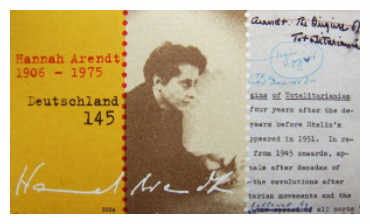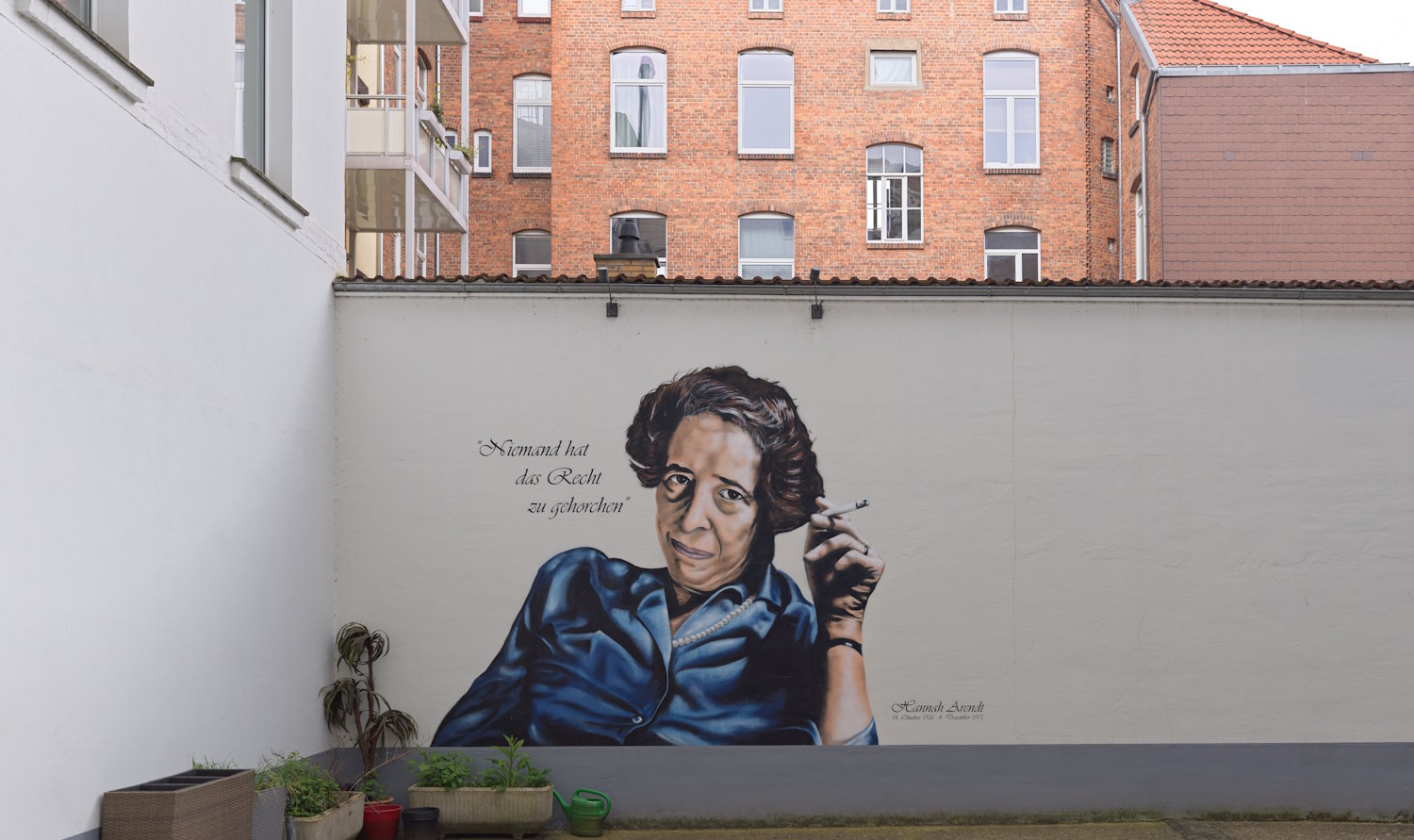Hannah Arendt and modernity: Hannah Arendt (1906-1975) is widely considered to be one of the most original and provocative philosophers of the post-World War II period
contents: introduction · life · the public realm · conclusion · further reading and bibliography · links · how to cite this article · see, also, hannah arendt and jean baudrillard: pedagogy in the consumer society

Life
Hannah Arendt was raised in Konigsberg, Germany, in 1906, the only daughter of secular Russian Jews. She excelled in her education and was reading Greek at an early age and wrestling with Kant in her mid-teens. She studied philosophy and theology at the University of Marburg and completed her doctorate at the University of Frieburg at the age of 23. Her most influential teacher, Martin Heidegger, had begun writing his magnum opus, Being and Time, shortly before they met. His rise to prominence as a philosopher and then position as an anti-semitic rector of Frieburg University has left countless scholars unraveling the secret intrigues of their short affair. But this must not be allowed to overshadow her life and her work.
As the Nazi’s rose to power Arendt fled to Paris where she spent over a decade during and after World War II helping European Jews flee to Palestine. While in Paris she met and married Heinrich Blucher, a Berlin gentile and active Marxist. After a brief period of internment the two were reunited and settled in New York City, where she spent much of the remainder of her life. Hannah Arendt remained bound by no academic institution, and held visiting fellowships and professorial positions at a variety of American universities including the New School for Social Research, Wesleyn, Berkley, Princeton, and Chicago. In 1975 she died with the first page of the final volume of The Life of the Mind in her typewriter. Yet even before her death her work was becoming noted, and today she is remembered as among the most illuminating and provocative intellectuals of our time.
The public realm
Appalled by what she observed in her own Germany, she argued that totalitarian mass movements were an unprecedented form of terror, unlike any previous forms of tyranny or despotism. For modern totalitarianism necessitated a rethinking of the Enlightenment project, cast doubt on the very notion of scientific and technological progress, exposed a “radical evil” at the very center of modernity. This is evinced in the modern calculative quest to dominate and reduce phenomena to instrumental matter to be worked upon and incorporated into the human project of technological mastery.
Hannah Arendt is a theorist of ruptures, reversals and distinctions: ruptures within the history of the West, reversals of human activities and their location, and the categorical distinctions necessary for their conceptual illumination. Nowhere is this more apparent than in The Human Condition, where Hannah Arendt outlines the three central human activities of labor, work, and action, which are each grounded in corresponding given “conditions” of human existence: life, worldliness, and plurality. The rise of the private activities of labor and work to a place of political dominance entails the eclipse of the public realm and of political action. This account of ruptures in the history of Western philosophy points towards the retreat of human freedom and potentialities through the reduction of difference and plurality to the sameness and conformity of the private and anti-political activities of production and consumption. Her endeavor was not to protect the private sphere of free, rights-bearing, rational autonomous agents, who engage in politics only so as to preserve their privacy; but rather critique the modern reversal of the relative importance of those activities which correspond to the private realm and those of the public.
Conclusion
Hannah Arendt wrote only briefly on education, in “The Crisis in Education”, where she asserts that “education is the point at which we decide whether we love the world enough to assume responsibility for it and by the same token save it from that ruin which, except for renewal, except for the coming of the new and young, would be inevitable.”[1]Yet her critique of modernity and account of political action and the public realm is profoundly relevant for educators and educational theorists who seek to locate their activity within a range of other human undertakings and within the context of the modern eclipse of public life. Hannah Arendt’s work points towards how we can fall short in our responsibility for, and love of, the world, and education can become complicit in the erosion of a vibrant and robust public realm.
Further reading and bibliography
Arendt, Hannah. The Human Condition. Chicago: University of Chicago Press, 1998.
Arendt, Hannah. The Origins of Totalitarianism. New York: Harcourt Brace Jovanovich. 1973.
Arendt, Hannah. Between Past and Future: Eight Exercises in Political Thought. New York, Penguin, 1968.
Arendt, Hannah. Eichmann in Jerusalem: A Portrait of the Banality of Evil. New York: Penguin, 1964.
Significant works on Hannah Arendt
Benhabib, Seyla: The Reluctant Modernism of Hannah Arendt. London, Sage, 1996.
Bernstein, Richard J: ‘Hannah Arendt: The Ambiguities of Theory and Practice’, in Political Theory and Praxis: New Perspectives, Terence Ball (ed.). Minneapolis, University of Minnesota Press, 1977.
Bernstein, Richard J: Philosophical Profiles: Essays in a Pragmatic Mode. Cambridge, Polity Press, 1986.
d’Entrèves, Maurizio Passerin: The Political Philosophy of Hannah Arendt. London, Routledge, 1994.
Habermas, Jürgen: ‘Hannah Arendt: On the Concept of Power’ in Philosophical-Political Profiles. London, Heinemman, 1983.
Hinchman, Lewis P. & Hinchman, Sandra K: ‘In Heidegger’s Shadow: Hannah Arendt’s Phenomenological Humanism’, in The Review of Politics, 46, 2, 1984, pp 183-211.
Kielmansegg, Peter G., Mewes, Horst & Glaser-Schmidt, Elisabeth(eds): Hannah Arendt and Leo Strauss: German Emigrés and American Political Thought after World War II. Cambridge, Cambridge University Press, 1995.
Villa, Dana: Arendt and Heidegger: The Fate of the Political. Princeton, New Jersey, Princeton University Press, 1996.
Villa, Dana (ed): The Cambridge Companion to Arendt. Cambridge, Cambridge University Press, 2000.
Young-Bruehl, Elisabeth. Hannah Arendt: For love of the World. New Haven: Yale University Press, 1982.
Links
Internet encyclopedia of Philosophy
Hannah Arendt and Jean Baudrillard: pedagogy in the consumer society
Note: [1] Arendt, Hannah. Between Past and Future: Eight Exercises in Political Thought. New York, Penguin, 1968, page 196.
Photograph – Hannah Arendt, portrait in the courtyard of her birthplace – by Hannes Grobe – Own work, CC BY-SA 4.0, https://commons.wikimedia.org/w/index.php?curid=148728155
How to cite this article: Norris, T. (2004) ‘Hannah Arendt and modernity’, The encyclopedia of pedagogy and informal education, www.infed.org/thinkers/arendt.htm.
Trevor Norris, Ontario Institute for Studies in Education, University of Toronto.
© Trevor Norris 2004
